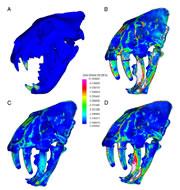 A lion skull (A) deals well with the forces from thrashing prey. But a Smilidon's jaw lights up with stress from the shaking (B), twisting (C) and pulling-back (D) of prey. Click here to view a larger image.PNAS
A lion skull (A) deals well with the forces from thrashing prey. But a Smilidon's jaw lights up with stress from the shaking (B), twisting (C) and pulling-back (D) of prey. Click here to view a larger image.PNASToothsome, not to mention fearsome, sabre-toothed cats actually had quite a weak bite, according to research that has implications for our understanding of how the animals hunted.
Researchers in Australia used what they say are the most detailed computer models ever developed of the vertebrate skull to determine the bite force of Smilodon fatalis, a cat (commonly but incorrectly called a tiger) that lived in the Americas from 2.5 million to 8,000 years ago1. The group predicts that a 230-kilogram Smilodon would have a bite force of about 1,000 Newtons from its 20-centimetre-long canines: about the same as that of a 80-kilogram jaguar and only a third that of a 250-kilogram lion.
The model could help to settle a long-running debate about how the beasts caught and dispatched their prey: did the cats bite into struggling prey, as a lion does? Or did they fight and pin animals to the ground before delivering a single fatal bite to the neck?
Colin McHenry and his colleagues say their model shows that the beasts had jaws too weak to withstand all the thrashing involved in the first method. Without a strong jaw, they must have relied on the instant killing power of their big teeth — lethal even when delivered by a weak bite.
Crash test
McHenry, a palaeontologist at the University of Newcastle in Callaghan, Australia, modelled the S. fatalis skull by splitting a digital representation of the bones into 2 million pieces or 'elements'. As with the pixels in a digital photo, the more elements there are, the higher the resolution. Previous models of Smilidon jaws had about 4,000 elements.
The model uses a technique called finite element analysis — also used by engineers when designing and virtually crash-testing cars — to produce a colour-coded map of strains on the skull resulting from biting, shaking, twisting and raking back on prey. Whereas a lion's skull copes well with such forces, a Smilodon 's "lit up like a Christmas tree" in the model, says McHenry.
"A lion has to wrestle hard to take a buffalo to the ground. If you imagine biting down while an animal tries to buck you off there is going to be a huge amount of load on the teeth," McHenry explains.
His results suggest that a sabre-toothed cat would have to ground and restrain an animal using other muscles, before delivering a precision bite to the neck. This is known as the 'canine shear bite' approach.
"There have been two opposing theories about sabre-tooth hunting," says Emily Rayfield, an expert in biomechanics and the modelling of fossils at the University of Bristol, UK. "This supports the canine-shear-bite theory," she agrees.
Body blow
François Therrien, curator of dinosaur palaeoecology at the Royal Tyrrell Museum of Palaeontology in Drumheller, Canada, who has previously suggested that the cats had a very strong bite2, agrees that the work shows a small jaw-closing force for the cats.
ADVERTISEMENT
But he argues that other muscles, in the neck for example, mean that the cats could still deliver a mighty blow with their teeth by throwing their body behind an attack.
"The study is of high quality and the results are extremely interesting," Therrien says. But he holds to his original conclusion about the ferocity of the beasts as hunters. If you take all those other muscles into account, he says, " Smilodon — and other sabre-tooths — delivered powerful bites."
Visit our catswereweakin.html">newsblog to read and post comments about this story.
